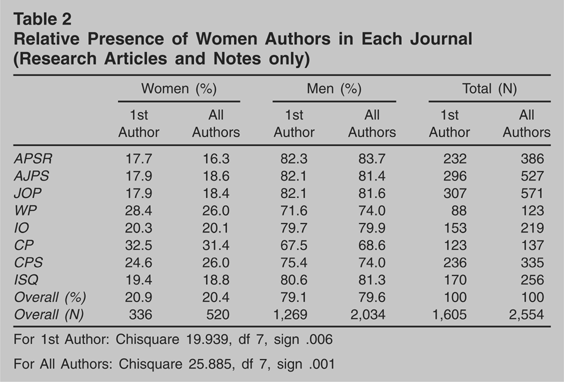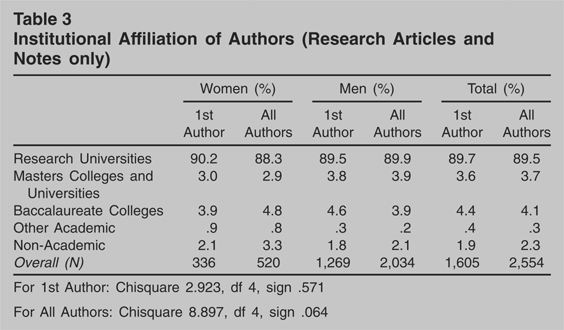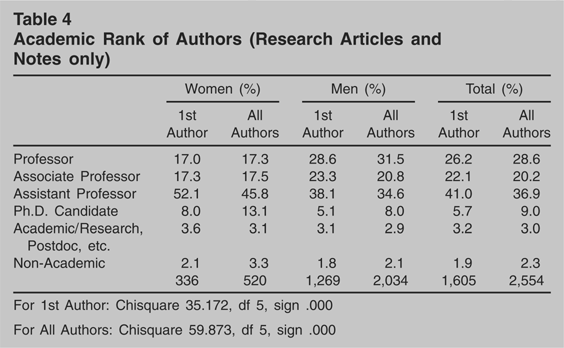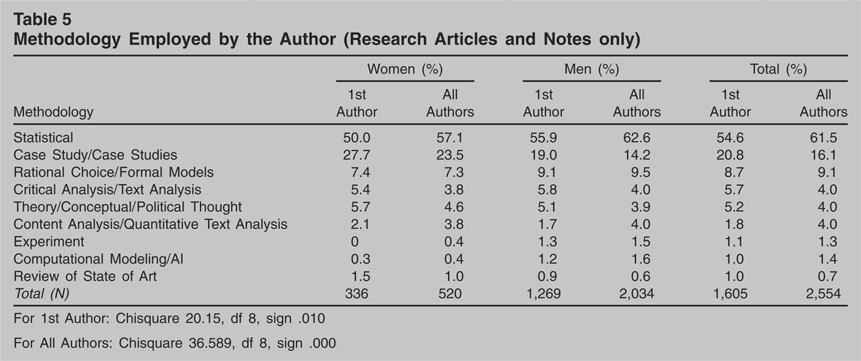How well are women authors represented in the most-recognized journals in political science? To what degree does the presence of women authors mirror women's presence in the discipline? Although a few studies have sought to provide data on the presence of women authors in political science journals (Young 1995; Kelly et al. 1994), more recent work on the visibility of women in the discipline has focused on gender and authorship of edited volumes (Mathews and Andersen 2001), on the participation of women in the APSA annual meetings (e.g., Gruberg 2006; 2004), and on the status of women in the discipline (Sarkees and McGlen 1992; 1999; Committee on the Status of Women in the Profession 2001). All are useful endeavors. This paper analyzes the presence of women authors in six volume years (1999–2004) of eight prestigious political science journals—American Political Science Review (APSR), American Journal of Political Science (AJPS), Journal of Politics (JOP), World Politics (WP), International Organization (IO), Comparative Politics (CP), Comparative Political Studies (CPS), and International Studies Quarterly (ISQ).
Literature
Although there have been a number of studies that have investigated journal content in political science generally or in a specific subfield (Kelly et al. 1994; Goldmann 1995; Young 1995; Norris 1997; Waever 1998; Aydinli and Mathews 2000; Bennett et al. 2003; Breuning et al. 2005), only two have investigated specifically the presence of women in political science journals (Kelly et al. 1994; Young 1995). In addition to journal content, a number of quantitative assessments have involved the ranking of political science departments (Garand and Graddy 1999; Hix 2004), the ranking of political science journals (Giles, Mizell, and Patterson 1989; Crewe and Norris 1991; Nisonger 1993; Garand and Giles 2003), or critiques of such rankings (Garand 1990; Lester 1990). Furthermore, there have been some investigations into who publishes. Here, the subject has alternatively been the connection between graduate training and productivity (McCormick and Bernick 1982; Rice et al. 2002), the gender gap in publishing (Mathews and Andersen 2001), and geographically based divides in publishing (Aydinli and Mathews 2000). Although most investigations of the discipline deal with publishing in academic journals, two focused on book publishing (Mathews and Andersen 2001; Rice et al. 2002).
About a decade ago, Young (1995) found that women are better represented in the profession than their work is in its journals. Is this still the case? In this paper, we investigate the relative presence of women authors in eight of the profession's prestigious journals.
Data and Methods
The selection of the eight journals was guided by the findings of studies that have sought to rank political science journals (Giles et al. 1989; Crewe and Norris 1991; Nisonger 1993; Garand and Giles 2003).1
Table 1 provides an overview of the rankings of the eight journals in these studies and also of the focus of each journal's content. Special emphasis was placed on the recent rankings of Garand and Giles (2003) and an effort was also made to include journals that publish work across political science subfields (APSR, AJPS, and, to some degree, JOP), as well as journals that tend to focus on a specific subfield, such as international relations (WP, IO, ISQ), comparative politics (WP, CP, CPS), and American politics (JOP). The apparent lesser emphasis on American politics is mitigated by the tendency of both the APSR and AJPS to include relatively more articles on American politics' subjects. The selected journals are each prestigious and have a broad impact in the field, not just among scholars in the U.S., but internationally as well.2Our justification for the selection of journals has much in common with Bennett et al. (2003).
Comparative Rankings and Foci of Journals

We employed a systematic content analysis to examine the contents of all issues of these eight journals for the most recent six completed volume years (1999–2004). Following Aydinli and Mathews (2000), Norris (1997), and McCormick and Bernick (1982), we coded research articles and notes, a total of 1,605 items. Since we are interested in data on authorship, we coded each author separately, resulting in an N of 2,554.
We recorded the name and affiliation of each author, and noted whether the author's affiliation was an academic institution. If so, we categorized the institution according the Carnegie Classification of Institutions of Higher Education (2000; 2001), which classifies American colleges and universities into nine categories. We collapsed these into Research Universities, Master's Colleges and Universities, Baccalaureate Colleges, and Other for our analysis.3
The Carnegie Classification distinguishes two types of Doctoral/Research Universities, two types of Master's Colleges and Universities, and three types of Baccalaureate Colleges. We collapsed these categories into Research, Master's, and Baccalaureate institutions, which also made it easier to provide comparative assessments of the non-U.S. institutions not classified by the Carnegie Foundation. The classification system also includes Associate's Colleges and Specialized Institutions. We added a category for non-academic authors.
Further, we coded the gender, academic discipline, and academic rank of each author. This information is generally discernable from the “Notes on Contributors” section.4
For AJPS, the oldest year included in the sample (1999) did not include biographical information on authors. Internet searches were used to ascertain the necessary information on the authors of that volume year of AJPS.
Subsequently, we recorded the number of authors for each piece, their rank order, how many among them were women, and the primary methodology of the article. To determine the most appropriate categorization regarding this last variable, we read the abstract, and sometimes the introduction and methods section to determine the most appropriate category for the item's methodology. We looked for a statement by the author regarding the article's methodology, which was especially helpful in the relatively few cases where multiple methods were employed. The author's statement helped us evaluate, e.g., whether the author considered the mathematical model or the statistical test as the core contribution of the item. We coded accordingly. The coding scheme for classifying each item's primary methodology was derived from Norris (1997), although we expanded the categories to create a more detailed classification.
The coding was completed by upper-division undergraduate students with training in political science methodology.5
The student coders are political science majors in a structured and sequenced program (see Ishiyama and Hartlaub 2003; Breuning et al. 2001). By the end of the sophomore year (and generally no later than the first semester of their junior year), these students have completed American Government, Introduction to International Relations, Political Science Methods, and Introduction to Comparative Politics. In the process, they have also completed at least one project requiring data collection, data entry, and statistical analysis, and one project applying the comparative method. Each project requires a review of the literature. Hence, these students have some familiarity with academic journals.
Findings
The objective of this investigation is to ascertain the relative presence of women authors in eight prestigious journals in political science. To aid in the interpretation of our findings, we obtained data regarding the proportion of women in both the American Political Science Association (APSA) and the International Studies Association (ISA). Women's membership in the various sections of APSA varies between a low of 19.9% for political methodology to a high of 92.3% for women and politics. On average, women account for 32.2% of APSA membership (averaged across the section memberships). Women's membership in sections of ISA shows a similar pattern: ranging from 12.1% for intelligence studies and 18.2% for scientific study of international processes (a methodologically oriented section) to 81.4% in feminist theory and gender studies. Overall, 31.8% of ISA's members are women.6
The data for APSA section membership are furnished by the APSA. The data for ISA membership were calculated from data provided by the ISA. The figures for both are for 2004.
Additional context is provided by Gruberg's (2006) reports on participation by women in the APSA's annual meeting. Gruberg (2005, 113) reports that in 1997 (two years prior to the first journal volume year we coded), 27.7% of the paper givers were women. By 2002, this figure had increased slightly to 28.6%, and in the past two years it has topped 30%. Gruberg's figures indicate that the proportion of women who are actively engaged in scholarship now approximates the proportion of women in both APSA's and ISA's membership.
Women's presence in the eight journals under investigation lags behind these figures, as shown in Table 2. Women make up an average of 20.9% of the authors if only the first author is considered, and 20.4% if all authors are considered. The journals differ in their propensity to publish research authored or co-authored by women. Whether we consider first authors only or all authors, research by women is least likely to appear in the APSR (17.7% and 16.3%, respectively) and most likely to appear in CP (32.5% and 31.4%, respectively). The percentage of women authors publishing in CP reflects the percentage of women in both APSA and ISA, making CP the only journal in this study that publishes research by women in proportion to their presence in these associations. WP and CPS are also above the average in the proportion of work they publish by women authors, as is shown in Table 2. Interestingly, all three focus either wholly or largely on comparative politics. Along with the APSR, the other generalist/Americanist journals (AJPS and JOP) are least likely to publish women authors, while the IR journals (IO and ISQ) fall in between. The differences in the propensity to publish the work of women authors among these eight journals are statistically significant both when only first authors and when all authors are considered.
Relative Presence of Women Authors in Each Journal (Research Articles and Notes only)

There are some factors that might explain why women are less present in these eight journals than in the associations (APSA and ISA), including where women are employed, their rank, and/or their methodological approach. We will turn to each of these factors.
The women authors in these journals are not significantly different from men in terms of their institutional affiliation. Table 3 shows that the authors are overwhelmingly affiliated with research-oriented institutions—primarily those classified as “Research I” in the Carnegie Classification of Higher Education (2000; 2001). Women authors have a slightly higher likelihood to be affiliated with specialized or associate's institutions (listed as “Other Academic” in Table 3) or to be employed in a non-academic setting, but the difference is not statistically significant.
Institutional Affiliation of Authors (Research Articles and Notes only)

Where women and men authors do differ significantly is in their academic rank (see Table 4), as has been noted by previous studies (Sarkees and McGlen 1992; 1999; Committee on the Status of Women in the Profession 2001). Women are more likely to be an assistant professor or a Ph.D. candidate, whereas men are more likely to be either full or associate professors.
Academic Rank of Authors (Research Articles and Notes only)

Women and men authors also differ significantly in terms of the methodologies they employ. Table 5 shows that statistical analysis is the most prevalent methodology. It is employed by just over half of all articles (54.6% of first authors) and 61.5% of all authors. The difference in the proportions of women and men authors who employ statistics is not huge. The difference becomes more obvious when we compare the relative use of case study methods (which are more likely to be employed by women) and rational choice or formal models (which are somewhat more likely to be employed by men). These findings mirror those of Breuning et al.'s (2005) study of international relations journals (IO, ISQ, WP), although the difference between women and men authors is somewhat less pronounced in this study. Additionally, the eight journals differ in their propensity to publish articles that employ statistical analyses: AJPS and JOP strongly emphasize statistics (75.0% and 72.0%, respectively), CP much less so (13.0% of articles employ statistics).7
The remaining journals have the following proportions of articles employing statistical methods, in declining order: CPS 55.1%, ISQ 51.8%, APSR 45.7%, WP 40.9%, IO 37.9%.
Methodology Employed by the Author (Research Articles and Notes only)

Journals also differ in their propensity to publish the work of junior scholars. The APSR is the least likely to publish work by junior scholars: assistant professors account for 33.2% of first authors and 29.3% of all authors. Whereas WP and CP publish the highest proportion of work by assistant professors (54.5% and 52.0% of first authors, and 43.9% and 51.1% of all authors, respectively).8
The remaining journals have the following proportions of assistant professor first authors (and all authors in parentheses), in declining order: AJPS 44.9% (40.0%), ISQ 44.7% (41.4%), IO 39.2% (35.6%), CPS 38.6% (36.4%), JOP 35.5% (32.9%).
Over half of all research articles and notes (55.9%) are single-authored. Of the single-authored items, three quarters (77.0%) are produced by men and one quarter (23.0%) by women. Of the 44.1% of items that are co-authored, almost two-thirds (63.4%) are co-authored by teams of two or more men and a little over one third (36.6%) are co-authored by teams that include one or more women. Of this last category, only 27 (or 1.7% of all research articles and notes) are produced by teams of two or three women. This replicates Young's (1995) finding that articles co-authored by women are almost non-existent. In addition, we found that 28.9% of all research articles and notes had at least one woman author, which is slightly higher than Young's (1995) finding of almost 24% of items with at least one female author.
Discussion and Conclusion
The data reflect an end-result that is influenced by a number of intervening factors, among which: women authors' decisions to submit their work, reviewers' judgments, and editors' decisions. These intervening factors are not easily studied. Journal editors do not necessarily track the gender of submitting authors.9
The current editors of the eight journals were contacted to request data on submissions by gender.
We thank Ilene P. Cohen (WP), Lisa Martin (IO), James Caporaso and Kathy Murray (CPS), and Steve Poe (ISQ) for furnishing the data that permitted us to calculate the percentages reported here.
At first glance, this data suggest that neither reviewers nor journal editors construct roadblocks to women authors. Of course, it is an open question as to whether the partial data reported here are indeed generalizable to the remaining journals. If they are, then the solution would be to encourage women to submit their work. However, it is also quite possible that women do not submit their work precisely because they perceive that their work does not fit the aims and scope of these journals.
The latter explanation has merit. The data show that women authors who did publish in these eight journals are somewhat more likely to employ case studies and slightly less likely to employ statistics or rational choice and formal models. Accordingly, they were more likely to publish their work in journals that publish such work and less likely to be found in journals that stress statistical analysis and/or rational choice and formal models. In addition, the journals differ in their propensity to publish the work of junior scholars. Again, women authors, who are more likely to be assistant professors or Ph.D. candidates, are more likely to be found in journals that are more likely to publish the work of junior scholars. Furthermore, these eight journals overwhelmingly publish authors (women and men) who are affiliated with research institutions. Other research has shown that women are less likely to be employed at such institutions and more likely to hold non-tenure track positions (APSA 2002; Sarkees and McGlen 1999; 1992), which may be a reason why the proportion of women authors publishing in these journals lags well behind women's presence in the discipline.
If so, greater visibility for women in the discipline's most prestigious journals depends on how each of these journals defines its aims and scope, its openness to various research methodologies (issues that journal editors can address), and on women's institutional affiliations or career paths (an issue that journal editors cannot address).
The under-representation of women in these eight journals does not necessarily mean that women publish less than their presence in the discipline would lead us to expect.11
It is possible that women authors publish more often in specialized or “niche” journals, which were not part of this study.
Author Bios
Marijke Breuning is associate professor of political science at Truman State University. She has published work on foreign policy analysis, foreign aid and development cooperation, and ethnic politics. She has also published on international studies curriculum and other pedagogical subjects. She is currently part of the editorial teams of the Journal of Political Science Education and Foreign Policy Analysis.
Kathryn Sanders is a senior majoring in political science at Truman State University. She has presented her research at several conferences and plans to pursue graduate education in communication.







